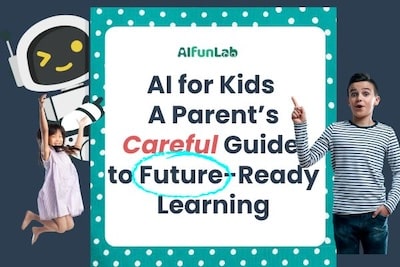Like most parents, I’ve tried everything to spark my child’s interest in science and coding — apps, STEM kits, workbooks. Nothing really clicked… until we unboxed a smart robot toy. It danced, responded to their voice, and asked questions back. They were instantly hooked.
Curious, I started looking into what really works for parents raising future-ready kids. Again and again, one thing came up: AI robot toys that encourage hands-on interaction over passive screen time.
As Harvard’s Center on the Developing Child explains,
“serve-and-return” interactions — where a child’s action gets a meaningful response — are key to building thinking skills early.
The best smart robots create that kind of dynamic learning through play.
2. What Is AI? A Simple Way to Explain It to Kids
As parents, we don’t need to “teach” AI like it’s a textbook subject. We just need to translate it into everyday language. Here’s how we describe it at home:
- AI is like a robot brain that learns by practicing—just like you do.
- It can see, hear, and talk using sensors and software.
- The more it experiences, the better it gets—like a kid learning to read or play chess.
From Netflix recommending their favorite cartoons to smart speakers recognizing their voice, AI is already part of your child’s life. A smart robot for kids just gives that invisible tech a personality—and puts it in their hands.
3. How Smart Robots Make AI Real for Kids
What makes a smart robot for kids so powerful isn’t just that it moves or makes noise. It’s how it introduces real AI concepts through play. Here’s how it breaks down:
3.1 Pattern Recognition
Kids might teach a robot to follow a line, respond to claps, or detect color. That’s AI noticing patterns—just like facial recognition or email filters do in real life.
3.2 Decision Making
“If X happens, then do Y.” That’s the core of algorithmic thinking—and robots make it tangible. A robotic kit for kids might let them program a robot to turn left when it hits a wall or play music when it detects sound.
3.3 Speech and Vision
Some smart robots respond to voice commands or use vision-based sensors. This introduces how natural language processing and computer vision work—the same tech that powers chatbots or self-driving cars.
Kids aren’t just learning about these things. They’re building with them.
4. Why Now? Global Momentum Behind Early AI Learning
You might be surprised to learn that in countries like China, South Korea, and India, AI is already entering the classroom—starting in elementary school.
- China mandates AI education from primary school, with kids as young as 6 learning AI basics by 2025.
- South Korea is rolling out AI-powered digital textbooks in 2025 to personalize student learning.
- India is integrating AI into national curriculums under its NEP 2020, backed by government/industry partnerships.
Meanwhile, many U.S. schools are still figuring out how to include basic computer science. That’s why more and more parents are turning to smart robots and robotic kits as at-home STEM solutions.
You don’t need to wait for a curriculum update. You can introduce your child to AI at home—today.
5. Why Smart Robots Are the Best First Step
You could start with apps or websites—but smart robots for kids have unique advantages:
- They’re tactile. Kids get to touch, build, and test their ideas in real space.
- They’re interactive. Feedback is immediate and engaging—it dances, it talks back, it changes course.
- They’re self-guided. Many kits adapt to your child’s pace, encouraging independent learning.
It’s also easier for you as a parent. You don’t need to know how to code. The robot does the teaching. You just get to watch the spark.
6. Coming Up Next: Which Smart Robot Is Right for Your Child?
In the next section, we’ll review the top 5 smart robots and robotic kits for kids in 2025—including current Amazon trends, age ranges, features, and which AI concepts each one supports.
We’ll also explore:
- The pros and cons of AI education at home
- A few trusted free AI games that work well with or without a robot
- How to choose the best robot toy based on your child’s learning style and interests
👉 Continue to Part 2: [Top Smart Robots to Teach Kids AI in 2025 →]
7. Top Smart Robots to Teach Kids AI in 2025
Now that we’ve explored why early exposure to AI matters, let’s look at the tools that make it happen.
These are the top-rated smart robots for kids and robotic kits for kids in 2025, based on product reviews, hands-on testing, and alignment with real educational outcomes. Whether your child is just starting or ready for advanced programming, there’s something here for every learning stage.
a. Miko 3: An AI Robot with Personality
- Age Range: 5–10
- Price: ~$249
- Key Features: Conversational AI, facial recognition, emotional intelligence training
- What Makes It Smart: Miko 3 uses natural language processing to chat with kids, tell stories, and adapt content to their learning preferences. It’s emotionally responsive, which makes learning feel like a relationship.
- Great For: Kids who love interaction and storytelling.
b. Makeblock mBot Neo: Code It, Build It, Watch It Learn
- Age Range: 8+
- Price: ~$149
- Key Features: Scratch and Python programming, line-following sensors, AI object recognition
- What Makes It Smart: Kids start with drag-and-drop coding and gradually move into real languages like Python. Built-in sensors let it “see” and respond to its environment.
- Great For: Future coders and STEM competition enthusiasts.
c. Botley 2.0: Screen-Free STEM Starter
- Age Range: 5+
- Price: ~$349
- Key Features: 100+ coding challenges, light/sound effects, no screen required
- What Makes It Smart: Botley helps young kids learn sequencing, logic, and loops—without using a tablet or phone.
- Great For: Parents who want a screen-free, tactile STEM experience.
d. Ruko Smart Robot: Budget-Friendly and Voice Controlled
- Age Range: 4–9
- Price: ~$84
- Key Features: Voice control, gesture sensors, programmable movement
- What Makes It Smart: Kids can issue voice commands, program basic behavior, and use an app for creative play.
- Great For: First-time robotics users or parents testing the waters.
e. LEGO MINDSTORMS Robot Inventor: The Ultimate Build-and-Code Kit
- Age Range: 10+
- Price: ~$629
- Key Features: Motors, sensors, Scratch & Python coding, 5 robot models
- What Makes It Smart: A professional-grade robotics system wrapped in LEGO fun. Introduces everything from basic motion to advanced AI.
- Great For: Advanced tinkerers, pre-teens, and future engineers.
8. Pros and Cons of AI in Education
AI isn’t just about convenience—it’s about empowering the next generation of creators. But it comes with caveats:
✅ Pros
- Personalized learning: Robots and apps adapt to each child's pace.
- Engagement: Kids are excited to learn when it feels like play.
- Skill development: Problem-solving, logic, and creativity all get a boost.
⚠️ Cons
- Screen time: Some tools are heavily app-dependent.
- Cost: High-quality robots can be expensive (though affordable ones exist).
- Tech dependence: Over-reliance on automation may limit freeform thinking if not balanced.
To ensure the best outcomes, pair robotics with other forms of play and exploration.
9. Free AI Games to Complement Learning
Don’t want to buy a robot just yet? These free AI games let kids explore real machine learning principles through fun, hands-on play.
🎮 Quick, Draw!
Google’s machine learning experiment where kids draw, and the AI guesses what it is—teaching how neural networks work.
🔗 Play Now
🧠 AI Dungeon
An AI-generated storytelling platform where kids choose actions and shape narratives in real time. Great for creativity and understanding natural language AI.
🔗 Try AI Dungeon
10. Final Thoughts + Call to Action
Smart robots aren’t just for tech camps and school labs anymore. They’re in homes, on living room floors, and in bedrooms where creativity comes to life.
By choosing the right smart robot for kids, you give your child a chance to:
- Build real-world tech fluency
- Develop curiosity and critical thinking
- Have fun while learning about the future
🎯 Ready to get started?
Choose one robot from the list above and introduce your child to AI through play. You don’t need a computer science degree—just curiosity and a little time together.
For over a decade, I've helped students get into top colleges. I've seen how many treat the acceptance letter as the finish line — but it’s really just the beginning. I also love creative writing and deep reading, and believe kids can be empowered through personalized learning and, ultimately, self-motivation. That belief drives my work at AIFunLab.io. MA in Education from Columbia.



.svg)





















